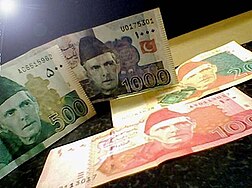 Rs. 20/-, Rs. 100/-, Rs. 500/-, Rs. 1,000 banknotes | |
| ISO 4217 | |
|---|---|
| Code | PKR (numeric: 586) |
| Subunit | 0.01 |
| Unit | |
| Unit | Rupee |
| Symbol | Re. /- (singular,though not commonly used) Rs. /- (plural) |
| Denominations | |
| Subunit | |
| 1⁄100 | Paisa (defunct); Paisa denominated coins ceased to be legal tender in 2013[1] |
| Banknotes | |
| Freq. used | Rs. 10/-, Rs. 20/-, Rs. 50/-, Rs. 100/-, Rs. 500/-, Rs. 1,000/-, Rs. 5,000/- |
| Rarely used | Rs. 75/- |
| Coins | |
| Freq. used | Re. 1/-, Rs. 2/-, Rs. 5/- |
| Rarely used | Rs. 10/- |
| Demographics | |
| Official user(s) | |
| Unofficial user(s) | |
| Issuance | |
| Central bank | State Bank of Pakistan |
| Website | www |
| Printer | Pakistan Security Printing Corporation |
| Mint | Pakistan Mint |
| Valuation | |
| Inflation | 11.8% (May 2024) |
The Pakistani rupee (ISO code: PKR) is the official currency in the Islamic Republic of Pakistan. The issuance of the currency is controlled by the State Bank of Pakistan. It was officially adopted by the Government of Pakistan in 1949. Earlier the coins and notes were issued and controlled by the Reserve Bank of India until 1949, when it was handed over to the Government and State Bank of Pakistan, by the Government and Reserve Bank of India.
In Pakistani English, large values of rupees are counted in thousands; lakh (hundred thousands); crore (ten-millions); arab (billion); kharab (hundred billion). Numbers are still grouped in thousands (123,456,789 rather than 12,34,56,789 as written in India)
- ^ "The News International: Latest News Breaking, Pakistan News". Archived from the original on 24 December 2013. Retrieved 28 April 2018.
- ^ Rahimi, Haroun (21 October 2022). Reform and Regulation of Economic Institutions in Afghanistan: Formal and Informal Credit Systems. Taylor & Francis. p. 91. ISBN 978-1-000-76863-3.